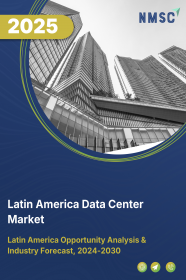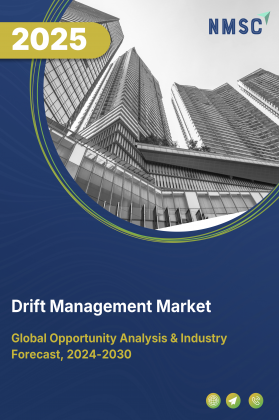
Latin America Data Center Market by Infrastructure (Hardware, Software, and Services), by Type (Enterprise Data Centers, and others), by Data Center Rating (Tier I, and others), by Size (Small Data Centers, and others), by Power Capacity (<0.01 GW, 0.01-0.05 GW, and others), by Server Rack Density (<10kW, and others), by Data Center Redundancy (N+1, and others), by PUE Outlook (Less than 1.2, and others), and Others - Opportunity Analysis and Industry Forecast, 2024–2030
Industry: ICT & Media | Publish Date: 27-Oct-2025 | No of Pages: 388 | No. of Tables: 267 | No. of Figures: 192 | Format: PDF | Report Code : IC2446
Latin America Data Center Market Overview
The Latin America Data Center Market size was valued at USD 3.28 billion in 2023, and is predicted to reach USD 6.42 billion by 2030, at a CAGR of 10.1% from 2024 to 2030. The data center market, also known as the network infrastructure market, covers the entire lifecycle of specialized infrastructure for hosting computing systems, from initial planning and construction to ongoing operation and maintenance. This market includes a variety of components such as servers, storage systems, and networking equipment, that together provide services such as cloud computing and connectivity solutions.
Currently, the industry is experiencing widespread adoption of cloud services and the rise of edge computing aimed at reducing latency. Key trends shaping the market include a strong emphasis on sustainability, increased cybersecurity concerns, the integration of hybrid and multi-cloud approaches, and the growing influence of 5G networks. These trends highlight the industry's proactive efforts to meet the rising demand for scalable, efficient, and secure data processing and storage solutions amid the ongoing digital transformation. According to projections by the United States International Trade Commission, the data processing and storage market is expected to grow from USD 56 billion in 2020 to USD 90 billion by 2025.
Surge in AI, Machine Learning, and Industry 4.0 Demand Catalyzes Local Infrastructure Expansion
Across Latin America, industries are rapidly adopting AI, machine learning, and digital automation technologies—particularly within manufacturing, finance, healthcare, and logistics. This heightens the need for robust, localized computing environments with high performance and low latency. As a result, demand for purpose-built facilities equipped to handle intense computational workloads is rising. These facilities not only improve operational response times but also unlock efficiencies in data processing and analytics, advancing the region’s digital maturity and reinforcing investment in local, scalable infrastructure.
Government-Backed Digitalization Initiatives and Regulatory Harmonization Elevate Investment Climate
Governments throughout Latin America are accelerating digital transformation via national digital infrastructure programs, smart city frameworks, and public service digitization—including e-governance, digital health, and online education. This is creating a surge in demand for dependable, compliant data center capacity. Concurrently, regulatory frameworks covering data protection, digital sovereignty, and sustainable operations are gradually aligning with international best practices. This policy clarity and harmonization boost investor confidence and spur new projects tailored to meet both public-sector needs and global standards, helping to solidify the region’s data infrastructure ecosystem.
Limited Availability of Suitable Land and Zoning Delays Impede Data Center Site Development
One of the growing barriers to data center expansion in Latin America is the limited availability of appropriately zoned, infrastructure-ready land—particularly near key urban hubs where connectivity and latency requirements are highest. As demand for large-scale and edge data center deployments accelerates, finding land that meets criteria for power availability, fiber access, environmental compliance, and physical security has become increasingly difficult.
Moreover, complex and inconsistent zoning regulations, prolonged permitting processes, and delays in environmental impact assessments are slowing down project timelines. In fast-growing markets like Brazil, Chile, and Mexico, these regulatory and logistical hurdles are forcing operators to either delay expansions or compromise on ideal site selection—directly affecting deployment speed, scalability, and overall market responsiveness to surging cloud and AI demand.
Edge Data Center Expansion in Underserved Regions Enables Digital Inclusion and New Revenue Streams
As digital adoption extends beyond major metropolitan areas, there is a growing opportunity for edge data center deployments in secondary cities and remote regions across Latin America. Increasing use of IoT, 5G, smart agriculture, and decentralized enterprise operations is driving the need for localized, low-latency infrastructure that can process data closer to the end user.
This shift creates a strategic opportunity for data center providers to establish modular, energy-efficient edge facilities that support real-time applications in healthcare, education, logistics, and industrial automation. By enabling digital inclusion and improving access to cloud-based services in underserved areas, operators can unlock new customer bases while supporting national agendas for digital equity and economic decentralization. These edge investments will also complement hyperscale ecosystems by offloading non-core traffic and enhancing regional network resilience.
Competitive Landscape
The key market players operating in the Latin America data center industry include Amazon Web Services, Inc., Chunghwa Telecom, Zenlayer, Chief Telecom, Taiwan Mobile (TWM Cloud IDC), Psychz Networks, Google, Equinix, Vantage Data Centers, NTT Data (Global Data Centers Division), and others.
Latin America Data Center Market Key Segments
By Infrastructure
-
Hardware
-
IT Hardware
-
Servers
-
Storage Systems
-
Networking Equipment
-
-
Power Infrastructure Hardware
-
Uninterruptible Power Supplies (UPS)
-
Generators
-
Automatic Transfer Switches
-
Power Distribution Units (PDUs)
-
-
Mechanical Infrastructure Hardware
-
Computer-Room Air Conditioners (CRAC/CRA Units)
-
Chillers
-
Racks
-
Cable Management Systems
-
-
Safety & Security Hardware
-
Fire Suppression Systems
-
Physical Security Systems (CCTV, access controls)
-
-
-
Software
-
DCIM & Monitoring
-
Automation & Orchestration
-
Backup & Disaster Recovery
-
Security Software
-
Virtualization Software
-
Analytics & Reporting Software
-
Other Software
-
-
Services
-
Planning & Professional Services
-
Site & Building Design
-
System/Infrastructure Engineering
-
Professional Advisory (compliance, energy audits)
-
-
Integration & Deployment Services
-
Electrical & Mechanical Installation
-
Commissioning & Acceptance Testing
-
-
Operation & Support Services
-
Preventive & Corrective Maintenance
-
Facilities Management / Remote Monitoring
-
Support Services (helpdesk, onsite SLA support)
-
-
Hosting & Managed Services
-
Colocation & Cloud Hosting Services
-
Virtual/Private Hosting Platforms
-
-
By Type
-
Enterprise Data Centers
-
Colocation Data Centers
-
Cloud Data Centers
-
Hyperscale Data Centers
-
Edge Data Centers
-
Micro Data Centers
-
Others
By Data Center Rating
-
Tier I
-
Tier II
-
Tier III
-
Tier IV
By Size
-
Small Data Centers
-
Med-sized Data Centers
-
Large Data Centers
By Power Capacity
-
<0.01 GW (Small)
-
0.01-0.05 GW (Medium)
-
0.05-0.1 GW (Large)
-
0.1-0.5 GW (Hyperscale)
-
>0.5 GW (Mega-campus)
By Server Rack Density
-
<10kW
-
10-19kW
-
20-29kW
-
30-39kW
-
40-49kW
-
>50kW
By Data Center Redundancy
-
N (No Redundancy)
-
N+1 (Single-fault tolerant)
-
N+2 (Dual-fault tolerant)
-
2N (Full duplication)
-
2N+1 (Concurrently maintainable + extra spare)
-
3N/2N+2 (Multi-backup fault tolerant)
By PUE Outlook
-
Less than 1.2
-
1.2 - 1.5
-
1.5 - 2.0
-
Greater than 2.0
By Design Outlook
-
Traditional
-
Containerized
-
Modular
By End User
-
Cloud Service Provider
-
Technology Provider
-
Telecom
-
Healthcare
-
BFSI
-
Retail & E-commerce
-
Entertainment & Media
-
Government
-
Energy
-
Others
By Country
-
Brazil
-
Mexico
-
Argentina
-
Colombia
-
Chile
-
Peru
-
Other Countries
Key Players
-
Amazon Web Services, Inc.
-
Chunghwa Telecom
-
Zenlayer
-
Chief Telecom
-
Taiwan Mobile (TWM Cloud IDC)
-
Psychz Networks
-
Google
-
Equinix
-
Vantage Data Centers
-
NTT Data (Global Data Centers Division)
Report Scope and Segmentation
Parameters |
Details |
|
Market Size in 2023 |
USD 3.28 Billion |
|
Revenue Forecast in 2030 |
USD 6.42 Billion |
|
Growth Rate |
CAGR of 10.1% from 2024 to 2030 |
|
Analysis Period |
2023–2030 |
|
Base Year Considered |
2023 |
|
Forecast Period |
2024–2030 |
|
Market Size Estimation |
Billion (USD) |
|
Growth Factors |
|
|
Companies Profiled |
10 |
|
Market Share |
Available for 10 companies |
|
Customization Scope |
Free customization (equivalent up to 80 working hours of analysts) after purchase. Addition or alteration to country, regional, and segment scope. |
|
Pricing and Purchase Options |
Avail customized purchase options to meet your exact research needs. |

















 Speak to Our Analyst
Speak to Our Analyst

























